What You Should Know Before Purchasing Princess Cut Diamonds All Entries

You cannot ignore princess cut diamonds when mentioning popular diamond shapes. Their sparkle and sharp corners explain why most brides want them on their engagement rings. You can also put princess cut diamonds on earrings, necklaces, and bracelets. With a square appearance, the diamonds’ pointed corners can have up to 76 tiny facets. What’s more, they resemble pyramids when placed upside down.
Selecting Princess Cut Diamonds
Despite bringing freshness to diamond jewelry, the absence of lab grades complicates the gem's purchase. Here’s what to consider when picking princess cut diamonds.
- Color
Like round shapes, princess cut diamonds divide light to conceal the rough material’s true color. You have to observe gems side by side to spot color variations. That notwithstanding, princesses show more color than round varieties.
Choose H or I shades when dealing with platinum or white-gold diamonds. Similarly, J shades complement yellow and rose gold rings while saving you money. Remember, color grades depend on the diamond’s body instead of its face-up hue. As such, gems rated below J face up brighter.
- Cut
Since fancy cuts are harder to evaluate than rounds, most laboratories don’t grade princess cut diamonds. That’s because princess cuts don’t have a benchmark. Although they might differ by their crown patterns and pavilion cuts, these factors don’t affect gem values. It all boils down to personal preferences.
Several factors come into play when evaluating the cut. The first one is the depth percentage. Since extremely shallow and deep cuts hinder light reflection, don’t exceed 65-75% depth percentage.
Another consideration is the table percentage that measures the top facet’s size against the width. As a rule of thumb, choose tables rated 75% and below. If you love small tables, prepare to scour the market, as these varieties are fewer than large tables. Furthermore, the length-to-width ratio shouldn’t go beyond 1.05, lest the stone appears off-shape.
- Clarity
Clarity grades determine how pronounced diamond imperfections are. Thanks to their brilliance, princess cut diamonds have less obvious inclusions. Classes SI1 (slightly included) and VS2 (very slightly included) promise eye-clean clarity at low prices.
However, SI1 stones are rare. Such is the case for SI2 and I1 categories. Pick a gem whose inclusions are invisible to the naked eye. Apart from dark spots near the center, avoid stones with inclusions on the edges, since weak corners invite chipping.
Setting Princess Cut Diamonds
A princess cut diamond's fragility calls for mountings that safeguard the stone’s edges. For example, channel settings enclose the stone between upright metal walls to create a smooth corridor. On the other hand, three-stone designs offer versatility, making them ideal for different occasions. As the name suggests, three-stone settings include three gems, with two accent stones and one center diamond.
You can mix shapes between the center and side stones and add gems like rubies, amethyst, and sapphires. Channel settings place the stone on the band instead of securing it with prongs. Since princess cut diamonds are square, channel settings support several stones without leaving gaps. This arrangement is popular for bridal and men’s wedding rings. Moreover, classic prong settings use less metal, allowing more light through the stone. In most cases, this arrangement features four prongs to secure and conceal the diamond.
Appraising Diamond Jewelry
Ralph Mueller & Associates has the gemologists who can ensure the authenticity and value of your pincess cut diamond ring through an appraisal. We can also assist you with selling your princess cut diamond ring if you need cash or no longer wear it. Contact us today to learn more.